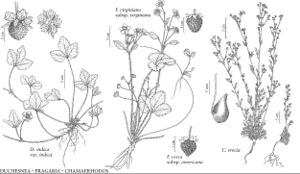Chamaerhodos
in C. F. von Ledebour, Fl. Altaica 1: 429. 1829.
Herbs, biennial or short-lived [long-lived] perennial, [0.3–] 0.6–3 dm, hispid-hirsute, soft-hairy, and stipitate-glandular [eglandular]; taproots woody, scaly. Stems 1 (–10), reddish tinged [green], simple or branched throughout, branches ascending or erect. Leaves basal winter-persistent, basal and cauline, rosulate, alternate, pinnately compound or simple and deeply pinnatifid; stipules absent; petiole present; blade obovate, 1.5–4 cm, herbaceous, 2–4-ternate, cauline sessile or petioles to 2 mm, blade 1–2-pinnate or pinnatifid, lobes linear-oblong, margins flat, entire, venation pinnate, 1 vein per lobe (lateral-veins not seen), surfaces hairy, stipitate [or sessile] glandular. Inflorescences terminal or often axillary, 10–many-flowered, crowded [sparse], flat-topped panicles; peduncles present; bracts present; bracteoles absent. Pedicels present or nearly absent [long-pedicellate]. Flowers 2–4 [–4.5] mm diam.; epicalyx bractlets 5, reduced to bristles proximal to sepal bases; hypanthium campanulate, 1.5–2.5 [–3.5] mm, exterior shiny-bristled, adaxially sparsely villous at rim; sepals 5, erect-ascending [recurved], ovatelanceolate [triangular], bristle-tipped; petals 5, white, obovate or cuneate-oblong, apex emarginate; stamens 5 (or 6), shorter than petals; torus absent; carpels 5–10 (–20), glabrous, styles lateral; ovule 1. Fruits aggregated achenes, 1–6, olivaceous to blackish [reddish to purplish at base], ovoid-pyriform, 1.1–1.4 [–1.6] mm, glabrous; hypanthium persistent; sepals persistent, erect-ascending (recurved); styles persistent. x = 7.
Distribution
North America, Asia
Discussion
Species 7 (1 in the flora).
Selected References
None.
Lower Taxa
"thin" is not a number."dm" is not declared as a valid unit of measurement for this property.
